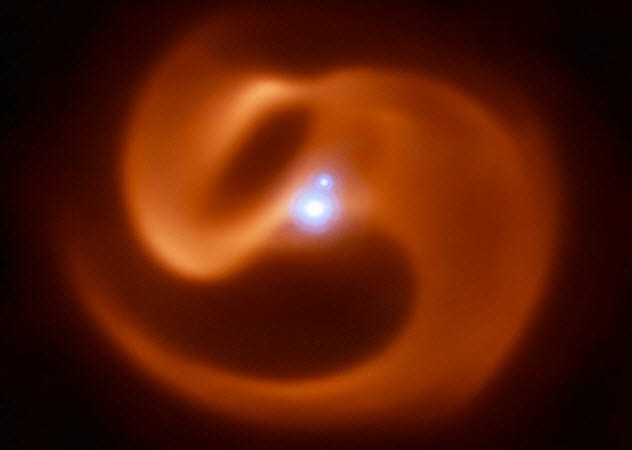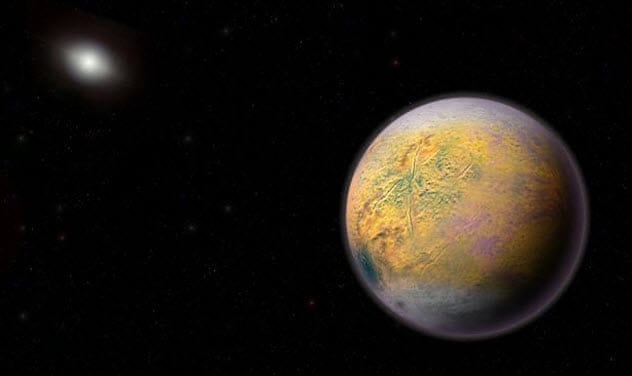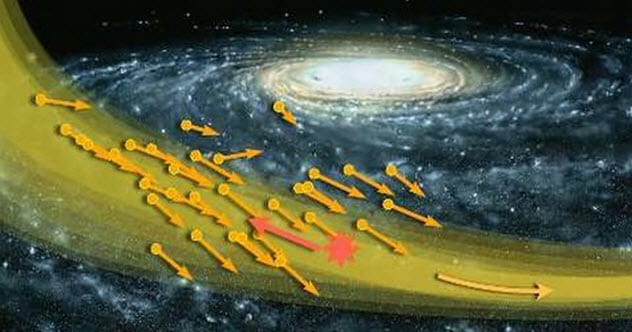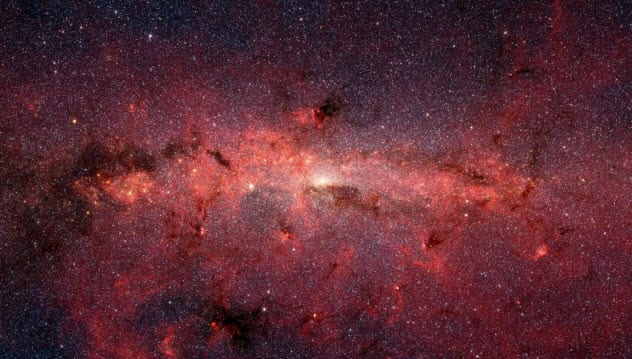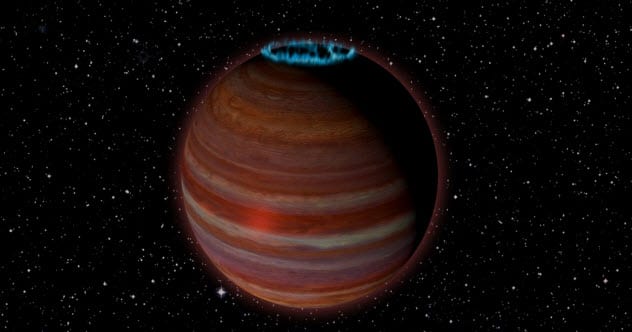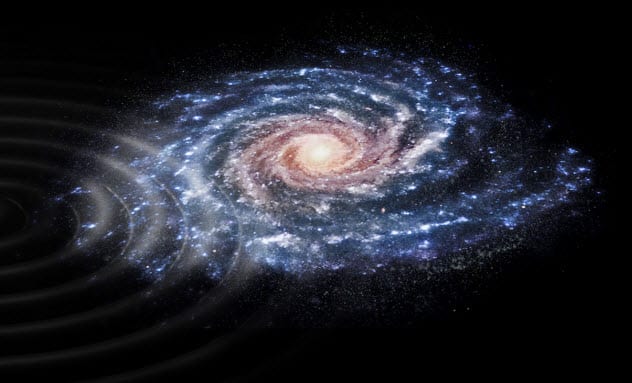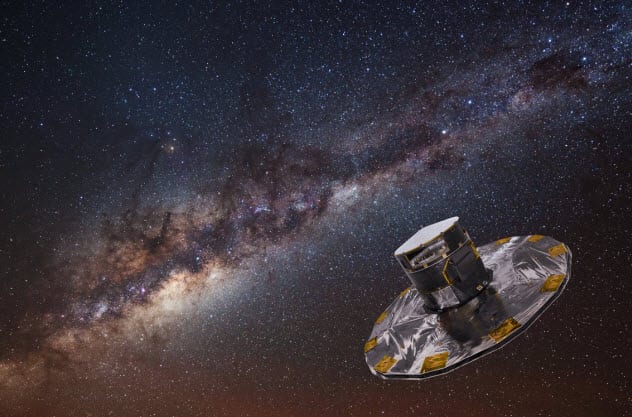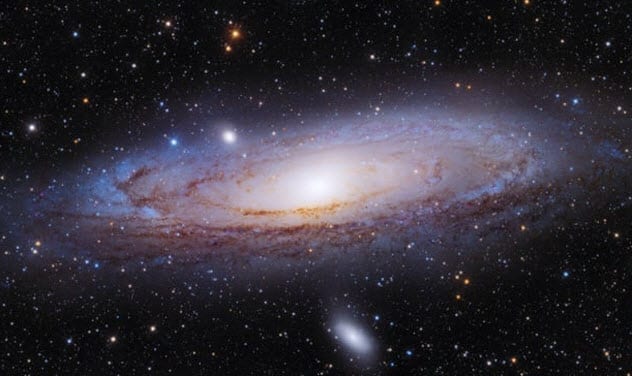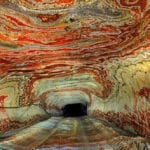There are dark matter storms, strange signals, and other first-time events. While great new finds are fodder for solving old questions, it is not just about what goes on inside the galaxy. The Milky Way has fought other galaxies, killed a few, and lives near the one opponent that will eventually destroy it.
10 Energetic Death Of Apep
In 2018, astronomers recorded a first for our galaxy. Within the Milky Way is a binary star system (two stars that orbit each other). They are Wolf-Rayet stars, which are supermassive dying suns. The system in our galaxy is burdened with the name 2XMM J160050.7–514245 but received the cool nickname of Apep. The latter was an Egyptian snake god that liked chaos. What makes the system unique is the aftermath of its death. Once Wolf-Rayet suns collapse, they release supernovas and gamma-ray bursts. The latter is among the most energetic and brightest events the universe can conjure—and never before in the Milky Way. Such bursts are rare, but Apep is a strong candidate. At the moment, the binary stars are spinning tightly around each other, throwing out bright streaks of matter in a pinwheel pattern.[1] Scientists do not know what causes this breakneck spinning, but this is one of the reasons why Apep could dissolve into a gamma-ray burst. Only Wolf-Rayet systems with enough speed, among other properties, can produce a gamma event.
9 The Goblin
Among the sought-after treasures hunted by astronomers is Planet 9. It is huge, somewhere outside the solar system, and very much theoretical. However, there are signs that the massive world exists. In 2018, scientists found a dwarf planet seemingly under the influence of something with huge gravitational clout. Something like Planet 9. The small frozen world was discovered around Halloween, which earned it the nickname “the Goblin.” But ghoulish names and supporting Planet 9 aside, the dwarf planet was exceptional in itself. Its path around the Sun is unique. The elongated orbit resembles a stretched rubber band and takes 40,000 years to complete a single circuit.[2] Due to living on the fringes of the solar system, the Goblin is visible for only 1 percent of its orbit. The discovery of this minor planet is also valuable because it adds to the threadbare picture of the outer solar system. It is the newest member of three minor planets populating this area. As a cluster, the trio also appears to be directed by a giant unknown object, most likely Planet 9.
8 Dark Matter Hurricane
In 2017, scientists found something heading toward Earth. For once, it was not an asteroid. Instead, it was a ribbon of stars slinging across the region of the Milky Way that contains our solar system. Named the “S1 stream,” it was the remaining remnant of a dwarf galaxy torn apart by the Milky Way. There is no danger of being bombarded by this rogue stream. However, the stars are not alone. Physicists believe that S1 could be hauling a massive load of dark matter that once held together the dwarf galaxy. Although labeled with the scary name of a “dark matter hurricane,” this event is good news. Thus far, technology has failed to find the mysterious substance because nobody knows what to look for.[3] Dark matter exists. But it is invisible and its composition remains unknown. However, when Earth and the hurricane meet, there is a chance that the local dark matter might spike. This signal could be the first physical measurement of dark matter ever recorded. In turn, this would finally prove its existence.
7 Mysterious Signal
Astronomers have listened to a strange signal for a while now. Two clues blamed dark matter. The signal originates from the center of the Milky Way, home to the so-called galactic bulge. The latter is like a clubhouse for gamma rays. A vast amount of these rays are packed into the bulge, and most studies have supported dark matter as the reason. Secondly, the signal’s smoothness was also what scientists expect of dark matter.[4] In 2018, a new study suggested that the bulge and signal had nothing to do with the mysterious dark stuff. Instead, they were caused by stars. This conclusion was made after scientists analyzed data from a telescope in a decade-long orbit around the Earth. It showed that the gamma-ray signals mirrored the position of ancient stars at the galaxy’s center. Called millisecond pulsars, some were as old as 10 billion years. Their distance from Earth could be behind the false “dark matter” signal. Traveling from so far away, their signals might have merged to resemble the even distribution of those from dark matter.
6 Toxic Space Grease
Space may appear empty, but it is filled with electromagnetic radiation, soot, and dust. In 2018, a study attempted to determine the amount of another peculiar ingredient—space grease. Technically, this goop is aliphatic carbon, an oily version of hydrogen-bound carbon. It is just one of the things stars throw out there. To estimate the volume, researchers created fake space grease. By observing its properties and comparing them with the real thing, the answer was surprising. The Milky Way is packed with up to three times more grease than previously thought. In other words, 11 billion trillion trillion tons. The sticky mess may be dirty and probably toxic, but it is a scientific darling. Carbon is an important building block of life, and this type is abundant. One day, it might explain how life-enriched solar systems, including our own, form in the Milky Way. It remains unclear why there is so much of this organic matter in space, but there is little danger of things becoming too sticky. Solar wind appears to prevent the grease from clogging up the galaxy.[5]
5 The Planet-Star Object
Around 20 light-years from Earth is a mysterious object. When first discovered in 2016, scientists thought it was a brown dwarf. Also called “failed stars,” these are bigger than planets but too small to fuse hydrogen and turn into stars. A recent study showed that the object was neither that simple nor easy to classify. SIMP J01365663+0933473 is a rogue body, which means that it has no solar system. At 200 million years old, it is also too young to be a brown dwarf. Incredibly, the object is something between a failed star and a planet. This big guy, with 12 times more mass than Jupiter, also soundly beat the latter at something else. Scientists were shocked to discover that SIMP’s magnetic field was 200 times more powerful than Jupiter’s.[6] The inexplicable strength of the magnetic field is as mysterious as the breathtaking auroras within it. Researchers hope that the oddity can kill two birds by revealing more about the magnetic lives of both stars and worlds.
4 An Ancient Wound
While studying a detailed map of the galaxy, researchers noticed something unusual. A cluster of stars behaved differently. To be fair, they orbited with the rest that swirled as a disk around the galactic center. However, caught in their own little world, these rogue suns also spiraled around each other. On a larger scale, the cluster resembled the curl of a snail’s shell. In 2018, scientists reversed time. They took the data of six million stars, including their position and velocity, and used it to unwind the snail. The models showed that the unusual shape was more of a scar. Around 300–900 million years ago, an immense gravitational disturbance hit the Milky Way and tore a piece out of place.[7] The main suspect was the nearby Sagittarius dwarf galaxy. Prior research found that the Sagittarius disk probably scraped by the Milky Way around 200 million to one billion years ago. This supported the new study perfectly. Ironically, the Milky Way is stealing stars from its Sagittarius neighbor and, 100 million years from now, will destroy the galaxy that wounded it.
3 A Dead Galaxy
This may sound weird, but inside our galaxy is the corpse of another. In 2018, scientists studied star movements within the Milky Way. Some two million measurements later, the study outed around 33,000 stars as foreigners born in another galaxy. The way that stars move reflects their origins, and this stellar clutch, nestled within the Milky Way, danced differently than the rest. Using this and chemical analysis of 600 of the guests, researchers calculated the age and size of the other galaxy. Once confirmed, the dead galaxy was called Gaia-Enceladus.[8] Around 10 billion years ago, Gaia-Enceladus was around one-fifth the size of our galaxy. The Milky Way had cannibalized dwarf galaxies in the past, but this one’s bulk made it a major galaxy to fall into ours. The result was a massive collision that destroyed Gaia-Enceladus. The event, which populated the inner part of the Milky Way with new stars, could explain why our galaxy’s disk is so thick. One thing is certain. If the crash had never happened, the Milky Way would look a lot different today.
2 A Lost Sibling
Our local galaxy cluster contains two heavyweights, the Milky Way and Andromeda, and many dwarf swirls. One of the tiny galaxies is M32. It hangs around Andromeda, but its composition was so weird that nothing could explain it. Extremely compact, it was nearly all core and lacked ancient stars. In 2018, astronomers were shocked by a third massive galaxy that once existed in the region. New research looked at Andromeda’s stellar halo. Previously, these stars were thought to be the crumbs of dwarf galaxies that Andromeda had preyed on in the past. Fresh evidence reassigned most of the halo to a galaxy that Andromeda had ripped up, even though it was nearly as big. Researchers now believe that this unlucky sibling was M32. Around two billion years ago, Andromeda likely ate everything but its core. This would explain why M32 looks so strange. The discovery is a grim reminder of the Milky Way’s future. It is on a collision course with Andromeda. Since the latter is twice as big, our galaxy will suffer the same fate as M32. Luckily, the end of the Milky Way is four billion years away.[9]
1 Strange Split
Recently, different countries turned their radio telescopes on the same thing—the black hole at the center of our galaxy. This was to snap the most detailed image yet of Sagittarius A. Radio telescopes sometimes photograph lines known as nonthermal radio filaments. They do not show up in the visual spectrum, and nobody knows what they are. One turned up in the Sagittarius photo shoot. Around 2.3 light-years long, it appeared to slither toward the black hole. The detailed imaging proved that the filament originated where it was found. Beyond that, answers became sparse. One theory suggests that the blending of magnetic fields can cause ribbons of super-excited particles. Sagittarius A could be spinning these streams from a magnetic field created through interaction with the gas clouds around it. The line could also be a crack in space. Called topological defects, they theoretically form when the growing vacuum of space causes a split. They are said to hold similar electrical currents and mass to the filaments, and the galactic center is their preferred playground. This is exactly where all the Milky Way’s filaments turned up.[10] Read More: Facebook Smashwords HubPages
